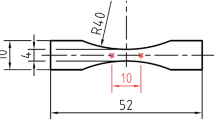Abstract
In order to accurately predict damage and failure evolution in metal forming processes such as stamping, blanking and bending, a finite element model has been developed which is valid for the numerical description of such processes. Numerical simulation of the damage evolution has been modelled by means of a continuum damage approach. The Lemaitre damage model which takes into account the influence of triaxiality has been implemented using the ABAQUS/Standard code. The model enables damage and fracture initiation to be examined under several different loading conditions and geometry configurations. An example of the L-bending process is given to illustrate the potential applicability of the model.















Similar content being viewed by others
References
Gurson AL (1977) Continuum theory of ductile rupture by void nucleation and growth. Trans ASME, J Eng Mater Technol 99:2–15
Hartley P, Pillinger I, Sturgess C (1992) Numerical modelling of material deformation processes research, development and applications. Springer, Berlin Heidelberg New York
McClintock FA (1968) A criterion for ductile fracture by the growth of holes. J Appl Mech 35:363–371
Predeleanu, Gilormini (eds) (1997) Proceedings of advanced methods in material processing defects international conference, Paris, July 1997
Huang MY, LU YH (1992) Elasto-plastic finite element analysis of V-shape sheet bending. J Mater Process Technol 35:129–150
Klingberg W, Singh UP, Urquhart W (1994) A finite element simulation of free bending. In: International conference on sheet metal, University of Ulster, 12–13 April 1994, pp 201–211
Makinouchi A, Nakamichi E, Onate E, Wagoner RH (1995) Prediction of spring-back and side-wall curl in 2-D draw bending. J Mater Process Technol 20:361–374
Oh SI, Kobayashi S (1980) Finite element analysis of plane-strain sheet bending. Int J Mech Sci 12:583–594
Kurt L (1985) Handbook of metal forming. McGraw-Hill
Leu DK (1997) A simplified approach for evaluating bendability and springback in plastic bending of anisotropic sheet metals. J Mat Process Technol 66:9–17
Marciniak Z (1992) Mechanics of sheet metal forming. Edward Arnold
Clift SE, Hartley P, Sturgess CEN, Rowe GW (1990) Fracture prediction in plastic deformation process. Int J Mech Sci 32:1–17
Chaboche JL (1981) Continuous damage mechanics – a tool to describe phenomena before crack initiation. Nucl Eng Des 64:233–247
Hambli R, Potiron A (2000) Numerical simulation of fine blanking process using the continuum damage mechanics approach. 8th international conference on sheet metal, Birmingham, UK, 17–19 April 2000, pp 489–496
Hambli R (1996) Etude expérimentale, numérique et théorique du découpage des tôles en vue de l'optimisation du procédé (in French). PhD thesis dissertation, ENSAM
Lemaitre J (1985) A continuous damage mechanics model for ductile fracture. J Eng Mat Technol 107:83–89
Date PP, Narashima K, Maiti SK, Singh UP (1999) On the prediction of spring back in vee bending of metallic sheets under plane strain condition. In: International conference on sheet metal, Earlangen, Germany, 27–28 Sept 1999, pp 447–456
Sidebottom OM, Gebhardt CF (1979) Elastic springback in plates and beams formed by bending. Exp Mech 371–377
Rice JR, Tracey DM (1969) On the ductile enlargement of voids on triaxial stress fields. J Mech Phy Solids 17:201–217
Kachanov LM (1958) Time of the rupture process under creep conditions. Izv Akad Nauk SSR Otd, Teckh Nauk 8:26–31
Lemaitre J (1992) A course in damage mechanics. Springer, Berlin Heidelberg New York
Criesfield MA (1991) Non-linear finite element analysis of solids and structures, vol 1. Wiley
Marques JMMC (1984) Stress computation in elastoplasticity. Eng Comp 1:42-51
ABAQUS HKS theory manual - Version 6.1
Author information
Authors and Affiliations
Corresponding author
Rights and permissions
About this article
Cite this article
Hambli, R., Mkaddem, A. & Potiron, A. Damage prediction in L-bending processes using FEM. Int J Adv Manuf Technol 22, 12–19 (2003). https://doi.org/10.1007/s00170-002-1435-7
Received:
Accepted:
Published:
Issue Date:
DOI: https://doi.org/10.1007/s00170-002-1435-7




